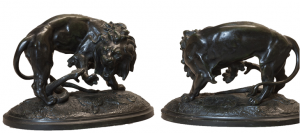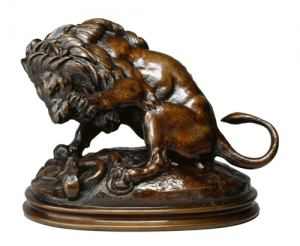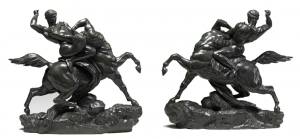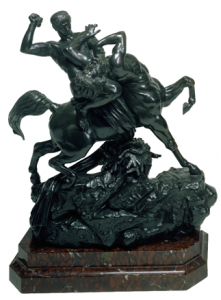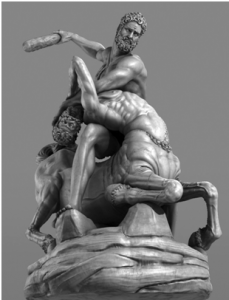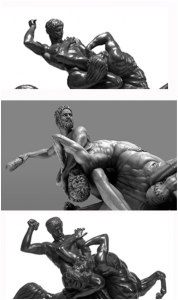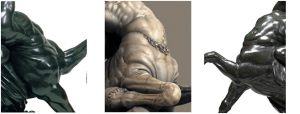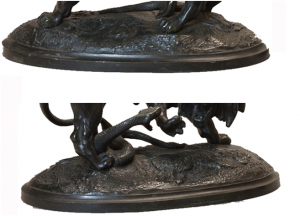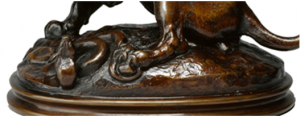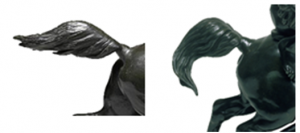Sculpting Elusive Animal Consciousness: A Monument to Barye
Man has forever been mesmerized by the vast animal kingdom. One man, fascinated with the sublime potential of nature’s inhabitants since birth[1], was Antoine Louis Barye. Barye’s Running African Elephant (c. 1830) (Fig 1.) demonstrates the artist’s aptitude for highly naturalistic yet expressive animal sculpture. Though many of his most well known works are of animals engaged in combat or simple predator or prey relationships, some of his subjects occasionally escape such brutal depiction. Two animals, which occasionally have this good fortune, are horses and elephants; Barye sculpts both horses and elephants with a quiet consciousness characterized by emotions more sophisticated than fear or aggression. Though his horse and elephant sculpture is not always imbued with elevated consciousness, a rich history of debate concerning the animal soul, enthusiastic observation at the Menagerie du Jardin des Plantes, potential exposure to the utility of exotic animals in French society, and the creatures’ consent to complete domestic work, may have provoked Barye’s anthropomorphic renderings.

Consciousness is not guaranteed in Barye’s equine and pachyderm subjects. Works like Elephant Killing a Tiger (c. 19th century) (Fig.2) and Horse Attacked by a Lion, (c. 1833) (Fig.3) place these animals firmly in their kingdom.


In these sculptures, the elephant shows his ability to brutally smear an overly ambitious tiger into the hard ground, and the horse leaps petrified into the air only to be anchored by several fierce lions. The forms are tense and dramatic with sharp angles, twisting muscles, and manipulated space. For example, in Elephant Killing a Tiger the elephant’s right shoulder flexes and smashes into viscera and stone narrowing the negative space between them into a tight crack. Similarly, in Horse Attacked by a Lion, the horse jackknifes up intensely; forearms and hawks stiff with fear, paw desperately into hopeless, empty space. In each case, the creatures forfeit their potential consciousness to their base psychological responses: fight or flight.
While horses and elephants clearly participate in typical primitive animal behavior, they also occasionally seem capable of higher communication. For this reason, the fate and quality of their souls has been the subject of philosophical debate for hundreds of years. French philosopher, Descartes, of the seventeenth century, felt that animals functioned without reason or thought, but on a strict track of physiognomic reactions. He claimed, “the animal body operated without the guidance of any non-corporeal principle. Indeed, a machine in the shape of an animal would be indistinguishable from the beast itself.”[2] Descartes’ disbelief in the animal soul and rational thought extended even to the idea that animals could not evaluate sensation (which lead to some heinous live dissections)[3]. By 1747, Descartes’ theory of animal automatism was generally irrelevant.
Though many agreed that Descartes was not correct, the status of animals’ souls and reason was not at all clear. In the early eighteenth century, Pierre Bayle’s theory that “all souls, including those of beasts, are by nature spiritual, yet held that only man’s soul is immortal”[4] gained traction. This entailed that animals had a temporary soul that lasted their earthly duration and of course, had the capability for sensation. Around the same time period, De Crousaz contributed to this idea with the theory that animals had,
“an inferior degree of thought not accompanied by immortality… Animals have not reflection, he asserted, no clear and distinct ideas, no faculty of comparing ideas, but they do have ideas of a sort, concerned with the conservation of the bodily machine.”[5]
This differed from man, in that man’s thought and reason was gifted from God, and thus his soul was immortal.[6] The qualities of these two theories, that if animals have a soul, it is transient, and if animals have reason it is inferior, make up the majority of discourse in the eighteenth century. Various philosophers would proportion each quality differently and temper it with different clauses, but the basis of each theory would loosely remain that animals have a “sensitive soul”[7] as best defined by David Renaud Boullier: “animals have a spiritual soul capable of sensation, by which he included a kind of thought falling short of pure reason… it deemed the animal soul non-spiritual yet thinking,”[8] or in other words, animals had some thinking faculty but were not as sophisticated or brilliant as man’s God given processes.
People who fell into this thought process generally operated under empiricism and looked to animal behavior as the only available indicator of consciousness.[9] This resulted in their assertion that the character of the soul lie in degree of complexity of the organism;[10] the more intricate the animal, the more “sensitive” their soul must be. The only thought of the time that rivaled this was that of the later free thinkers, who “actually destroy any distinction between human and animal soul.”[11] The idea that animals and man had an identical soul, did not withstand for most people who felt their observations defied this, and human arrogance or logic, Bayle’s theory remained.
This eighteenth-century philosophy informs Barye’s work. His approach to animal subjects seems to favor the idea that complex organisms contained ability for rational thought, though that thought was not always dominant, as seen by the impassioned subjects in Elephant Killing a Tiger and Horse Attacked by a Lion. One tabletop animal sculpture that seems to contain a measure of consciousness is, Running African Elephant (c. 1830’s). This elephant is extremely naturalistic and correctly proportioned. The lines in Elephant are curving, flicking, arching, snapping, active lines which propel his foreword motion. The s-shaped lines comprise the shape of his front and back right leg, his arched tail, his spine, and principally, his trunk, all of which suggest that this figure is a vibrant, energetic, exciting composition. The elephant’s body is expertly balanced; the capable adventurous creature moves foreword with assured agency. His body curls slightly left while it leans slightly right to counter the motion the feet too seem to be “moving” in a highly realistic, somewhat circular rotation. Even the red and green patinas clearly play off each other pulling details to the forefront of the viewer’s vision with the red patina, and giving more subtle, rounded definition with the green patina, all backed by a deep mocha background. For example, the bone structure in the elephant’s face is lit with copper highlights from the red patina, while the green patina rounds the segments of the trunk, and fills the flat ear flaps, giving them greater depth. The contrast and saturation of the patinas give physical vigor and personality perhaps evident, along with the multitude of naturalistic and activating elements, of some consciousness in Running African Elephant.
The lively consciousness exhibited by Barye’s Running African Elephant is similarly present in his work, Half-Blood Horse, With Head Down (19th century) (Fig.4, 5). Though subdued in comparison to the elephant, this horse is no less keen. She is made of long sloping lines; the most prominent of which starts at her muzzle, extends up her brow, over her bridal path, down her long, lean neck, over the small peak of her withers, into the sway of her spine, over her round haunches, and out into her gently arched tailbone. Her weight is balanced, not firm, but shifting, hovering in a moment of evaluation, as she listens, ears flicked back. The movement in her body is implied as she is in a moment before her back left leg steps forward; her ears swivel, her nose twitches, her raised tail, unlike the back and forth wagging of a dog’s, will rise vertically up and flick back down before she settles again. She stretches her head, sniffing the air in active observation. The color of the bronze is a rich mahogany brown, amber in some places, and rosy where the light touches her shapely features. For example, her mantle, shoulder, rump not only catch the light, but are lighter in color, highlighting the most active indicators of her movement. It is as if the color of the sculpture mimics the tone of a real horse’s bay coloring. Despite not being on a raucous adventure like the African elephant, this elegant creature’s consciousness is in her awareness and observation of the world around her and the delicate rendering of her naturalistic qualities.


Barye’s ability to sculpt animals, especially these emotively complex elephant and horse works, probably arose from his dedicated observation at Paris’s Jardin des Plantes. The Jardin des Plantes, which contained plants and animals, was part of a complex of museums with a variety of disciplines. Charles Sprauge Smith writes, “In the Garden the different animals are to be seen living, moving behind the bars of their cages; in the Museum of Zoology you will find them stuffed; in the Museum of Comparative Anatomy… you can study their skeletons as connected wholes.”[12] With these vast resources at the Jardin des Plantes, it becomes a bit more understandable how Barye perfected his craft. Smith explains, “Barye made constant use of every facility of instruction afforded by the Garden”[13] complex. The artist even developed an amicable relationship with a member of the staff, Pére Rousseau, who would call him to come inspect animals that had died so he might draw diagrams, take measurements, or make notes about the animal’s anatomy.[14] Barye exposed himself to an entire world of natural history, and with such vast and intense investigation, mastered animal sculpture.
Around the time Barye was studying the materials at the Jardin des Plantes, a zoologist named Isidore Geoffroy Saint-Hilaire was working at the Museum National d’Histoire Naturelle.[15] He spent the early part of his career “writing and lecturing about exotic animals and their utility to agriculture, industry and society”[16] at the Museum. Geoffry Saint-Hilaire’s interest in exotic animals arose from France’s investigation in their colonies, Algeria being one such colony. He had “a well-developed notion of which exotic animals were likely to be useful not only in France but also in her colonies,” and it was his knowledge of the colonies’ animals that would lead him to form a sister institution to the Jardin des Plantes.[17] The Society Zoologique d’Acclimation, heaed by Geoffry Saint-Hilaire, focused on the potential benefit of domesticating foreign, sometimes Algerian animals, for French society.
Considering Barye spent every day in the museums, and Geoffroy Saint-Hilaire spent two decades of this time lecturing, it is not impossible to suppose Barye may have heard some of his lectures. Saint-Hilaire’s writings “were distinctly anti-Cuvierian in tone,”[18] Cuvierian referring to Georges Cuvier, who Saint-Hilaire had invited to Paris in 1795, and became a professor of animal anatomy at the Museé National d’Hisoire Naturelle shortly after[19]. Cuvier prescribed to similar philosophies as Descartes, as previously described. If Barye made contact with the zoologist in all his time at the Jardin and Museums, his work could be directly influenced by the idea that exotic Algerian animals could be domesticated for the purpose of French society, and maybe even persuaded or reassured in his beliefs, also probably anti-Cuvierian due to the reverence and monumentality of his animal sculptures, that animals maintained some quality of consciousness.
Even if Barye did not make contact with Geoffroy Saint-Hilaire or his writings, many European powers were looking to foreign colonies for resources. Europe felt a God-given right to colonize, and simply saw the drive to colonize as evidence of an extremely advanced society intent on spreading civilization.[20] One of the perks of colonizing an area was consuming and transporting its resources, some of which were animal. European “naturalists identified dozens of species like the trumpeter and zebra as untapped resources awaiting domestication”[21] according to traveler’s reports.[22] Writers Jean Baptiste François Hennebert and Gaspard Guillard De Beaurieu even felt that while “Wild animals might seem to live in enviable conditions, free from man’s tyranny… But overall, domestic animals are happier, especially when treated well”[23] because they evaded certain natural challenges like finding food, shelter, and protection.[24] With God’s endorsement and obvious profits, European nations invaded foreign countries, and consumed their animal resources, among others, with zeal.
In the difficult process of colonization, animals that were stolen from exotic countries did not always fair well on their journey to France. Louise E. Robbins writes in her book Elephant Slaves and Pampered Parrots, that when food aboard the exploring ships was entirely gone, all livestock was game for consumption by the crew.[25] Occasionally domestic animals like dogs were victims to the starving voyagers.[26] Even starving humans act according to some hierarchy when searching for sustenance; animals that survived the odds possessed “a value that placed them above consumable creatures, as is evident in the reluctance to eat them even in extreme circumstances.”[27] Their value was debatable, but generally, animals that possessed some kind of anthropomorphic consciousness survived the longest. Robbins writes, “those who had been teaching their parrots a new language held out the longest”[28] from turning them into edible protein. In summary, animals that showed an aptitude and willingness to communicate with humans kept their lives longer than those animals that did not.
Barye seems to identify this quality for animal cooperation, or animals’ decision to participate in human work, especially in works like Surtout de Table: Tiger Hunt (1834-1836) (Fig.6) and Arab Horseman Killing a Lion (c. 1830’s) (Fig.7) where horses and elephants carry human riders into combat against predators.


In these sculptures, elephant or horse and man work as one to dominate predators like tigers and lions respectively. Considering elephants and horses are the only animals sculpted in this uniquely loyal position, it is possible that part of Barye’s concession to instilling consciousness in his equine and pachyderm subjects was due to their consent to carry human masters into potentially lethal circumstances.
Ultimately, Barye sculpts elephants and horses with acute consciousness even when they are not acting on behalf of their human masters. In works like Running African Elephant and Half-Blood Horse, With Head Down where the animals are not in a manmade setting, wear no tack, and complete no domestic chores, elephants and horses are occasionally afforded an emotive consciousness more sophisticated than the base reactions of predator and prey animals. Due to Barye’s exposure at the Jardin des Plantes and in French society in general, it is possible that the artist directly translates the familiar utility and loyalty of the horse to the new Senegalese resource, the elephant, and thus expresses a French desire to translate foreign colonies’ culture into recognizable European terms.
Regardless of his goals, the evidence that Barye sculpted elephants and horses, among other animals, with consciousness has not gone unnoticed in history; Smith writes, “the new element which he has discovered and added, [is] the immortal soul [which] he has breathed into bronze.”[29] Though there is not a decisive visual guide that defines the presence of the animal soul, and there may never be a consensus about the existence of the animal soul, Barye’s works begin a visual discussion of how we might appreciate and locate elusive animal consciousness
[1] Charles Sprague Smith. “Barye.” In Barbizon Days, 187. Freeport: Books for Libraries Press, 1902.
[2] Leonora Chohen Rosefield. From Beast-Machine to Man-Machine. New York: Octagon Books, 1968. 6.
[3] Rosefield. From Beast-Machine to Man-Machine, 18-20.
[4] Rosefield. From Beast-Machine to Man-Machine. 75.
[5] Rosefield. From Beast-Machine to Man-Machine. 76.
[6] Rosefield. From Beast-Machine to Man-Machine. 76.
[7] Rosefield. From Beast-Machine to Man-Machine. 80.
[8] Rosefield. From Beast-Machine to Man-Machine. 78.
[9] Rosefield. From Beast-Machine to Man-Machine. 109.
[10] Rosefield. From Beast-Machine to Man-Machine. 125.
[11] Rosefield. From Beast-Machine to Man-Machine. 123.
[12] Smith, Barbizon Days, 194.
[13] Smith, Barbizon Days, 194.
[14] Smith, Barbizon Days, 195.
[15] Michael A. Osborne. Nature, The Exotic, and the Science of French Colonialism. Bloomington and Indianapolis: Indiana University Press, 1994. 2.
[16] Osborne. The Science of French Colonialism. 3.
[17] Osborne. The Science of French Colonialism. 7.
[18] Osborne. The Science of French Colonialism. 4.
[19] Ben Waggoner. “Georges Cuvier (1769-1832).” WWW.UCMP.BERKELEY.EDU. 1994. Accessed December 23, 2014. http://www.ucmp.berkeley.edu/hisotyr/cuvier/html
[20] Louise E. Robbins. Elephant Slaves and Pampered Parrots: Exotic Animals in Eighteenth-Century Paris. Baltimore and London: Johns Hopkins University Press, 2002. 188.
[21] Robbins. Elephant Slaves. 188.
[22] Robbins. Elephant Slaves. 188.
[23] Robbins. Elephant Slaves. 197.
[24] Robbins. Elephant Slaves. 197.
[25] Robbins. Elephant Slaves. 9-12.
[26] Robbins. Elephant Slaves. 11.
[27] Robbins. Elephant Slaves. 12.


